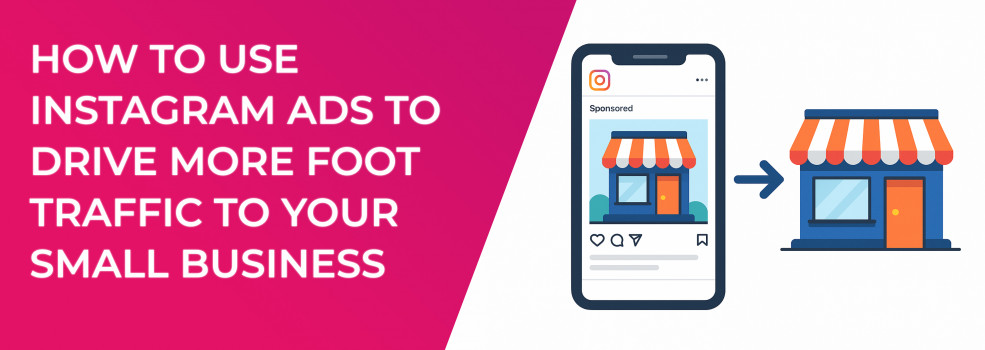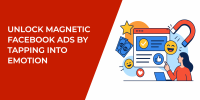Small-business success still depends on real people walking through your door, yet persuading busy locals to drop by can be a challenge. Instead of waiting for passers-by, meet them where they already spend time by using Instagram ads. With precise location targeting and engaging visuals, you can invite nearby customers to visit in person and turn online interest into real-world foot traffic.
Why Instagram Ads Work for Local Businesses
Instagram has evolved far beyond pretty photos. With more than a billion users and robust Meta ad tools, it offers hyper-targeted local marketing. You can show ads to people in a specific neighborhood, based on their interests and habits, and prompt them to visit your location.
From screen to sidewalk: see the journey that transforms a view into a visit.
While the average conversion rate for Instagram ads varies by industry, small businesses that target smartly and keep content relevant often see solid returns. A well-crafted ad can drive both online conversions and real-world actions, such as walking into your store or booking a service.
Step 1: Define What “Conversion” Means for You
Decide what success looks like before spending a dollar. Is it someone visiting your shop, calling to book an appointment, or attending an event? Once you pick a goal, shape your Instagram content writing for conversion to match. If you want walk-ins, make that obvious in the creative: “Show this post in-store for 15 percent off” or “Come by today for a free sample.”
If you’re unsure which objective will push walk-ins over the line, this guide on choosing the right Meta ad campaign objective breaks down each option.
Step 2: Use Location-Based Targeting
Location targeting is the secret sauce. When you build your ad, narrow the audience to a city, zip code, or radius around your storefront. A downtown coffee shop gains little by advertising to someone two counties away. Staying local stretches your budget and can lift the conversion rate for Instagram in your area.
Key location filters to try:
-
Pin-drop radius (for example, a one-mile circle around your address)
-
Multiple zip codes that match common commuter routes
-
City limits when you want wider reach for an event or launch
-
Advanced behaviors like “Recently in this location” to catch tourists
For a deeper dive into interest, behavior, and demographic filters, see Facebook Ad Targeting 101 before you set your radius.
A good rule of thumb: start tight, then widen gradually until your business conversion rates for Instagram stabilize. Keep an eye on the typical conversion rate for Instagram ads in your vertical. If it climbs past your local benchmark, you have found your sweet spot. If not, shrink the radius and sharpen your creative.
Step 3: Run Click-to-Map or Story Ads
Story ads generate quick engagement, but click-to-map formats (also called local awareness ads) shine for visits. They include a button like “Get Directions,” guiding customers to you in one tap. To stand out, try video. Many of the best conversions for Instagram come from businesses that showcase their space, staff, or unique vibe. A short clip of your barista pouring latte art or your boutique’s latest arrivals often beats a static photo.
Video sells the vibe: short Reels give viewers a taste of your in-store experience.
Need creative inspiration? These tips on using Instagram Reels in your marketing strategy show how short video can spark higher engagement and in-store visits.
Step 4: Mind the Timing
Knowing the best times to post on Instagram for conversion can make a big difference. If weekends are busiest, schedule ads to ramp up on Friday. If lunchtime traffic matters, post mid-morning to influence meal decisions. Review Instagram Insights to see when your followers are online and adjust accordingly.
Quick timing wins to experiment with:
-
Commuter hours (7–9 a.m. and 5–7 p.m.) to catch people heading past your location
-
Lunch window (11 a.m.–1 p.m.) for cafés, restaurants, and quick services
-
After-work surge (4–6 p.m.) for retail, fitness, or happy-hour promos
Once you identify your peak windows, test several creative hooks in rotation. Pair eye-catching visuals with clear calls to action and you will soon notice which slots deliver the highest conversion rates for Instagram. Even a modest bump of half a percent can translate to dozens of extra walk-ins per week.
Step 5: Track What Works and Double Down
Wondering what are good conversion rates for Instagram ads? Benchmarks differ, but brick-and-mortar retail often considers 1–3 percent healthy, while service brands may see higher rates with strong offers. Instead of chasing generic averages, focus on improvement. Use the Meta Pixel, point-of-sale data, or a simple “How did you hear about us?” question at checkout to measure results. If you prefer automation, try the Kit virtual assistant to handle using Kit for Instagram ads success conversion reminders and reporting. Test different formats, calls to action, and promotions until you discover the mix that pushes your average conversion rate for an Instagram ads campaign beyond your baseline.
If your numbers stall, troubleshoot with the advice in Facebook ads not converting: how to fix it.
Bonus Tip: Scale With Lookalike Audiences
After a few winning campaigns, create Lookalike Audiences. By modeling ads on your existing customers, you reach new people who resemble your best shoppers, which can lift your average conversion rate for Instagram ads while reducing costs over time.
Scale without guesswork: lookalikes help you find more people like your best customers.
Wondering when to switch tactics? This comparison of custom vs. lookalike audiences can help you decide which audience type will scale your results faster.
Final Thoughts
Instagram ads aren’t just for online brands. With smart targeting, engaging visuals, and clear calls to action, they can turn likes into leads and followers into foot traffic. Start planning your next campaign today, track performance closely, and watch your sidewalk get busier.

